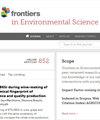滤水器:野外快速水环境 DNA 采集器
IF 3.3
3区 环境科学与生态学
Q2 ENVIRONMENTAL SCIENCES
引用次数: 0
摘要
利用环境 DNA(eDNA)技术进行的生物监测已从微观生物扩展到宏观生物。在水生 eDNA 研究中,需要在野外快速过滤大量的水,这就需要开发有效的 eDNA 采集设备。在本研究中,我们介绍了一种新型便携式 eDNA 采集系统,该系统包含一个 GM 双通道滤水器和一个适用于大型滤膜(ø 100 毫米)的 DNA 提取试剂盒。滤水器由大容量锂电池(9000 毫安)供电,可驱动两个蠕动泵,在室外环境中保持高达 1 升/分钟的连续过滤速度达 5 小时。样品采集的最佳条件是静水和浊度低于 8 nephelometric 浊度单位。使用 0.22-μm 过滤器可在 10 分钟内过滤 10 升水。元基因组和 12S 元条码测序表明,我们为该系统量身定制的 DNA 提取试剂盒的 DNA 提取质量和物种注释准确性可与现有试剂盒媲美。GM 水过滤器的富集模式与真空过滤的结果一致,大大缩短了大量水样的过滤时间,同时准确地再现了物种注释。这项创新简化了 eDNA 的采集和注释过程,为生物多样性监测和保护工作带来了巨大效益。本文章由计算机程序翻译,如有差异,请以英文原文为准。
Water filter: a rapid water environmental DNA collector in the field
Biological monitoring using environmental DNA (eDNA) technology has expanded from micro- to macro-organisms. In aquatic eDNA studies, large volumes of water need to be filtered rapidly in the field, which requires development of effective eDNA collection devices. In this study, we introduce a novel portable eDNA collection system containing a GM dual-channel water filter and a DNA extraction kit adapted to large filter membranes (ø 100 mm). The water filter is powered by a high-capacity lithium battery (9,000 mA), which operates two peristaltic pumps and maintains a continuous filtration rate of up to 1 L/min for 5 h in outdoor settings. For sample collection, the optimum conditions are still water and turbidity below 8 nephelometric turbidity units. This allows for the filtration of 10 L of water within 10 min by use of a 0.22-μm filter. Metagenomic and 12S metabarcoding sequencing showed that the DNA extraction quality and species annotation accuracy of our custom DNA extraction kit, which was tailored for this system, rivaled the performance of established kits. The GM water filter’s enrichment mode gave consistent results with vacuum filtration, which greatly reduced the filtration time for large water samples, while accurately reproducing species annotations. This innovation streamlines the eDNA collection and annotation process and offers substantial benefits for biodiversity monitoring and conservation efforts.
求助全文
通过发布文献求助,成功后即可免费获取论文全文。
去求助
来源期刊

Frontiers in Environmental Science
Environmental Science-General Environmental Science
CiteScore
4.50
自引率
8.70%
发文量
2276
审稿时长
12 weeks
期刊介绍:
Our natural world is experiencing a state of rapid change unprecedented in the presence of humans. The changes affect virtually all physical, chemical and biological systems on Earth. The interaction of these systems leads to tipping points, feedbacks and amplification of effects. In virtually all cases, the causes of environmental change can be traced to human activity through either direct interventions as a consequence of pollution, or through global warming from greenhouse case emissions. Well-formulated and internationally-relevant policies to mitigate the change, or adapt to the consequences, that will ensure our ability to thrive in the coming decades are badly needed. Without proper understanding of the processes involved, and deep understanding of the likely impacts of bad decisions or inaction, the security of food, water and energy is a risk. Left unchecked shortages of these basic commodities will lead to migration, global geopolitical tension and conflict. This represents the major challenge of our time. We are the first generation to appreciate the problem and we will be judged in future by our ability to determine and take the action necessary. Appropriate knowledge of the condition of our natural world, appreciation of the changes occurring, and predictions of how the future will develop are requisite to the definition and implementation of solutions.
Frontiers in Environmental Science publishes research at the cutting edge of knowledge of our natural world and its various intersections with society. It bridges between the identification and measurement of change, comprehension of the processes responsible, and the measures needed to reduce their impact. Its aim is to assist the formulation of policies, by offering sound scientific evidence on environmental science, that will lead to a more inhabitable and sustainable world for the generations to come.
 求助内容:
求助内容: 应助结果提醒方式:
应助结果提醒方式:


